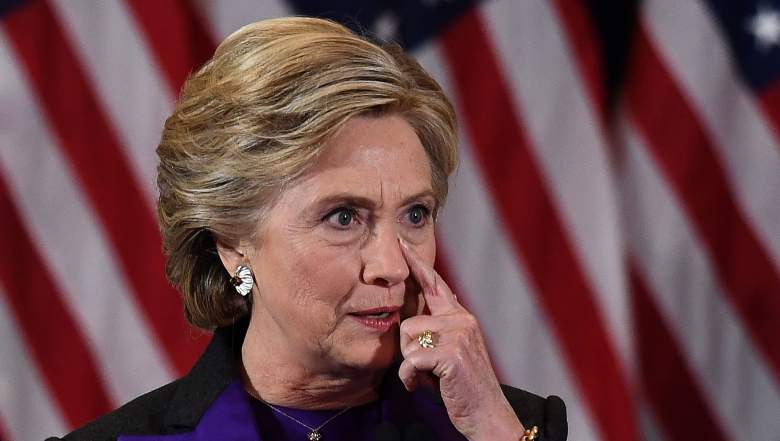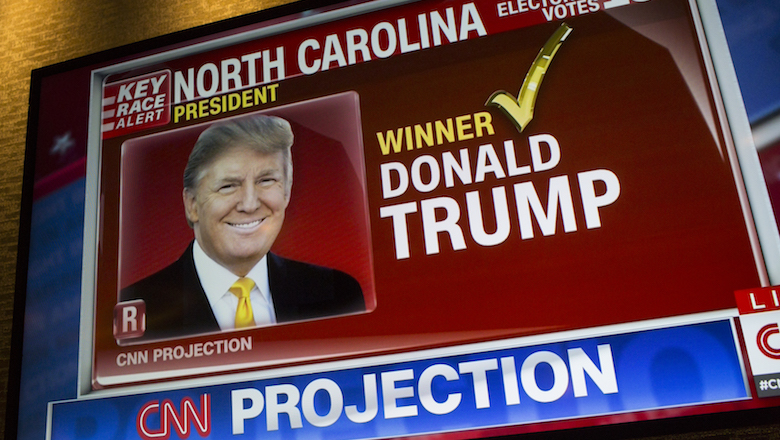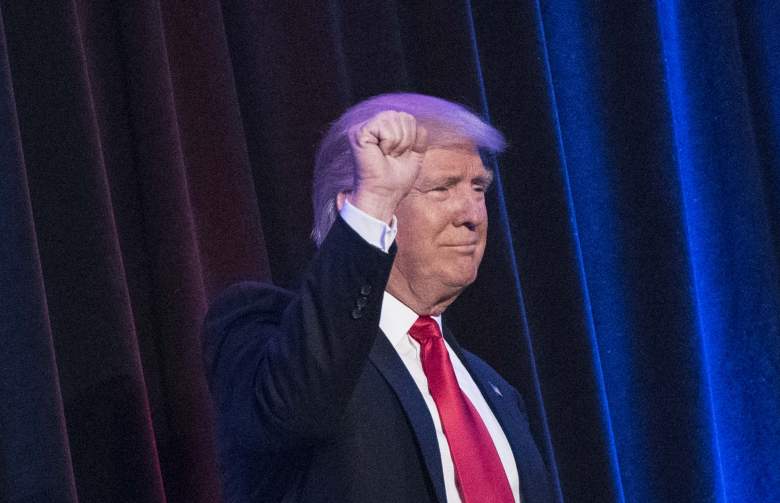
Hillary Clinton pauses as she makes a concession speech after being defeated by Republican President-elect Donald Trump, in New York on November 9, 2016. (Getty)
Donald Trump won the Electoral College and is the president-elect. Hillary Clinton won the popular vote.
Is there any scenario at all through which Hillary could still become president? Enter the “Faithless Elector” scenario.
“Faithless Electors,” according to FairVote.org, “are members of the Electoral College who, for whatever reason, do not vote for their party’s designated candidate.” In other words, electors bound for Trump could just change over to Clinton or not vote.
It’s a highly improbable scenario because Trump leads the Electoral College by so much, but that hasn’t stopped millions of people from embracing it as a last-ditch effort to prevent a President Trump from becoming the Leader of the Free World. At any rate, what hasn’t been improbable about this election?
You can get a full list of each state’s electors here. In some states, they are party activists, making it a far tougher and more remote task that they could flip.
Here’s what you need to know:
1. Millions of People Have Signed a Petition Asking the Electors to Switch or Abstain

Inauguration Day is not until January 20, 2017. Trump has already met with President Barack Obama. (Getty)
Over 3.6 million people have signed a petition on Change.org asking electors to pick Clinton when the Electoral College meets on December 19 to cast its ballots (The U.S. Congress meets in joint session to count the electoral votes on January 6; Inauguration Day is January 20).
The petition notes, “Mr. Trump is unfit to serve. His scapegoating of so many Americans, and his impulsivity, bullying, lying, admitted history of sexual assault, and utter lack of experience make him a danger to the Republic.”
According to the National Conference on State Legislatures, the Electoral College “was established by Article II, Section 1, Clause 2 of the U.S. Constitution and modified by the 12th and 23rd Amendments. The Electoral College consists of a total of 538 members, one for each U.S. senator and representative, and three additional electors representing the District of Columbia.”
The NCSL adds: “Each state has a number of electoral votes equal to the combined total of its congressional delegation, and each state legislature is free to determine the method it will use to select its own electors.”
2. There Have Been Faithless Electors Before in American History

The phrase “Not My President” has been used at all of the anti-Trump rallies, and it has also been turned into a popular Twitter hashtag. (Getty)
The New York Post noted, “According to the Constitution, chosen electors of the Electoral College are the real people who will vote for president, when they meet on December 19 in their respective state capitals.”
Since the advent of the Electoral College, there have been 157 faithless electors. According to FairVote.org, “71 of these votes were changed because the original candidate died before the day on which the Electoral College cast its votes. Three of the votes were not cast at all as three electors chose to abstain from casting their electoral vote for any candidate. The other 82 electoral votes were changed on the personal initiative of the elector.”
The National Conference of State Legislatures says “the last time an elector crossed party lines was in 1972, when an elector nominated by the Republican Party cast his ballot for the Libertarian ticket.”
The challenge for Clinton supporters: Because of Trump’s lead in the Electoral College, a swarm of electors would need to do so.
3. It’s Illegal in Some States for Electors to Switch but the Penalty Is Not Severe

Protesters hold up signs and yell during a protest against the elction of Donald Trump in the Boston Common on November 9, 2016 in Boston, Massachusetts. (Getty)
FairVote says 21 states “still do not require their members of the Electoral College to vote for their party’s designated candidate” and the 29 states that do impose low penalties for violating the rule, including fines and misdemeanors charges. FairVote even has a list of past faithless electors.
According to Inverse, “The precedent in most previous cases has just been to charge faithless electors with a misdemeanor and slap them with a fine, usually $1,000.” Inverse argues that the best way to encourage faithless electors is to raise money for their legal fees.
Here is the list of states that attempt to bind their electors to sticking with the candidate their state voted for, according to the State Conference of State Legislatures:
Alabama, Nebraska, Alaska, Nevada, California, New Mexico, Colorado, North Carolina, Connecticut, Oklahoma, Delaware, Ohio, District of Columbia, Oregon, Florida, South Carolina, Hawaii, Tennessee, Maine, Utah, Massachusetts, Vermont, Minnesota, Virginia, Michigan, Washington, Mississippi, Wisconsin, Montana, Wyoming.
The SCSL says, in addition to laws that require electors to vote as pledged, in some states, a faithless elector can be replaced with another elector. “No elector has ever been penalized or replaced — nor have these laws been fully vetted by the courts,” the SCSL adds.
4. Some Electors Were Already Threatening to Become “Faithless”

The FairVote.org site says the last time the nation saw a faithless elector was in 2004 when an anonymous Minnesota elector voted for John Edwards when he or she was pledged to vote for John Kerry. Some people thought that was done by mistake, though.
Before the 2016 presidential election, Time Magazine talked to some electors who said they would become faithless electors. Some of them were Bernie Sanders voters.
However, Vox points out that, when a candidate wins a state, his or her party nominates the electors. Vox cites the example of Alaska, where there is a Republican Party “nominated elector slate there — former Gov. Sean Parnell, Jacqueline Tupou, and Carolyn Leman.”
That means the party’s electors would need to turn on the Republican president-elect. It would be shocking, to say the least, and highly unlikely. After all, why would Republicans want to give the election to Hillary (although, it’s been a shocking election from start to finish, and there’s no love lost between Trump and some factions of the GOP. Then again, everyone loves a winner.)
5. Trump Has a Large Lead in the Electoral College, Making This Scenario Tougher to Pull Off

Donald Trump. (Getty)
Trump’s large lead in the Electoral College makes this scenario a lot harder to imagine. The New York Times’ electoral map says Trump has 290 electoral votes to 228 for Clinton; Michigan was still listed as up for grabs with its 16 additional electoral votes.
The New York Times lists these popular vote totals for each candidate:
Clinton: 60,839,497
Trump: 60,265,847
Clinton’s popular vote tally now exceeds 61 million, according to a popular election tracker by Dave Wasserman and Cook Political Report.
The Electoral College is designed so that candidates must try to appeal to the hearts and minds of people in every state instead of only focusing on the few most populous areas.